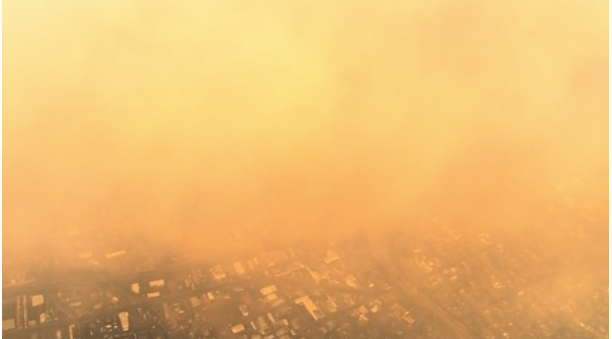
By Marc Vartabedian
SANTA ROSA, Calif. (Reuters) – A spate of wildfires fanned by strong winds swept through northern California’s wine country on Monday, leaving at least 10 people dead, destroying hundreds of homes and businesses and chasing some 20,000 people from their dwellings.
The deaths marked the first wildfire-related fatalities in California this year, according to state officials, and are believed to represent the largest loss of life from a single incident or cluster blazes in the state in about a decade.
Governor Jerry Brown declared a state of emergency for Napa, Sonoma and Yuba counties, encompassing some of the state’s prime wine-making areas, as the blazes raged unchecked and engulfed the region in thick, billowing smoke that drifted south into the San Francisco Bay area.
He later extended the declaration to include four more northern California counties and Orange County in Southern California.

An aerial photo of the devastation left behind from the North Bay wildfires north of San Francisco, California, October 9, 2017. California Highway Patrol/Golden Gate Division/Handout via REUTERS
Sonoma County bore the brunt of the fatalities, with seven fire-related deaths confirmed there, according to the sheriff’s department. Two others died in Napa County and one more in Mendocino County, according to the California Department of Forestry and Fire Protection (CalFire).
Details on the circumstances of those deaths were not immediately available from either CalFire or local officials. But KGO-TV in San Francisco, citing unnamed California Highway Patrol officials, described one of the victims as a blind, elderly woman found dead in the driveway of her home in Santa Rosa, a town in Sonoma County.
Two hospitals were forced to evacuate in Sonoma County, state officials said.
Thousands of firefighters battled wind gusts in excess of 50 miles per hour (80 km/h) that have rapidly spread 15 separate wildfires across some 73,000 acres in northern California since erupting late Sunday night, according to CalFire spokesman Daniel Berlant.
About 1,500 homes and commercial buildings have been destroyed throughout the region, Ken Pimlott, director of CalFire, said at a news conference.
A separate wildfire on Monday torched at least a half-dozen homes in the affluent Anaheim Hills neighborhood of Southern California’s Orange County, forcing the evacuation of hundreds of residents there, authorities said.

Firefighters work to put out hot spots on a fast moving wind driven wildfire in Orange, California, U.S., October 9, 2017. REUTERS/Mike Blake
That blaze erupted along a freeway off-ramp and spread quickly in gusty winds to scorch at least 4,000 acres (1,600 hectares) in a matter of hours, fire officials said.
Still, the fire in Orange County paled in comparison to one of the fiercer blazes in northern California, the so-called Tubbs fire, which by mid morning had scorched about 25,000 acres (10,117 hectares) in Napa and Sonoma counties, an area world-famous for its vineyards.
One evacuee, John Van Dyke, recalled standing in his pajamas near the 101 Freeway in Santa Rosa, watching a hillside in flames from the Tubbs Fire, when police pounded on his door in the mobile home park early on Monday, telling him to flee.
“When I got in the car to leave, a whole section of the mobile park was in flames,” he said. “It scared the hell out of me.” At least 5,000 people were under mandatory evacuation orders in Santa Rosa alone, accounting for about a quarter of the region’s residents displaced by the fires.
San Francisco authorities issued an air quality alert due to smoke from the fires, which residents said they could smell since early in the morning.
“You can’t see anything, the smoke is very dense,” Fred Oliai, 47, owner of the Alta Napa Valley Winery, told Reuters by telephone. He said he has not been able to get close enough to his vineyards since he was evacuated to see if flames reached his 90-acre property.
In addition to potential damage to vineyards from fire itself, experts say sustained exposure to heavy smoke can taint unharvested grapes, and Oliai said wine makers in the area are nervous.
“We got our grapes in last week, but others still have grapes hanging,” he said.
The region threatened by fires overlaps an area accounting for roughly 12 percent of California’s overall wine production by volume but also where its most highly valued grapes are grown, said Anita Oberholster, a professor of viticulture and enology at the University of California at Davis.
So far this year, some 7,700 wildfires in California have burned about 780,000 acres statewide as of Sunday, CalFire spokesman Daniel Berlant said.
About a dozen people lost their lives in a series of fires that swept San Diego County and other parts of Southern California in October 2007. Ten people perished the following August in the Iron Alps Fire Complex in northern California’s Trinity County, including nine killed in a helicopter crash.
(Additional reporting by Alex Dobuzinskis in Los Angeles, Keith Coffman in Denver and Gina Cherelus and Joseph Ax in New York; Writing Alex Dobuzinskis and Steve Gorman; Editing by Tom Brown and Diane Craft)
















